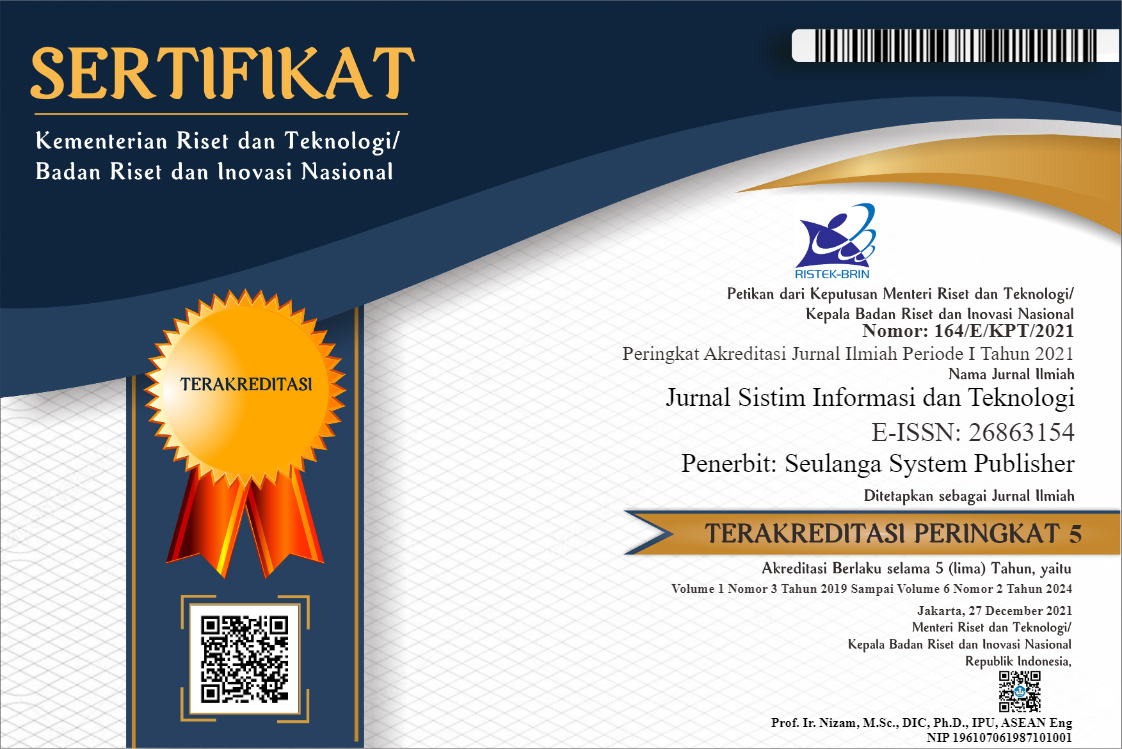Sistem Deteksi Intrusi pada Server secara Realtime Menggunakan Seleksi Fitur dan Firebase Cloud Messaging
DOI:
https://doi.org/10.37034/jsisfotek.v5i1.161Keywords:
Attack, Intrusion Detection, Firebase, Network, SecurityAbstract
Intrusion detection is one of the fundamental parts of a security tool, such as adaptive security tools, intrusion detection systems, intrusion prevention systems and firewalls. There are various kinds of intrusion detection techniques used, the main problem of this intrusion technique is the performance problem. The accuracy of the intrusion detection technique greatly affects its performance, which needs to be improved to reduce the false alarm rate and increase the detection rate. In solving performance problems, multilayer perceptron, support vector machine (SVM), and other techniques have been used recently. This technique shows limitations and is inefficient for use in large data sets, such as system and network data. Intrusion detection systems are used in analyzing a very large data traffic; thus, an efficient classification technique is needed to overcome these problems. This issue is considered in this paper. The well-known machine learning techniques, namely, SVM, random forest, and extreme machine learning will be applied. These techniques are well known for their ability to classify. NSL knowledge discovery and data mining datasets were used, which were considered as benchmarks in the evaluation of intrusion detection mechanisms. The results show that ELM outperforms other approaches. Utilization of Firebase Cloud Messaging because it can work with multiple platforms in addition to the availability of a file store that can store all logs created by the JALA application.
References
Anwar, F., Khan, B. U. I., Olanrewaju, R. F., Pampori, B. R., & Mir, R. N. (2020). A comprehensive insight into game theory in relevance to cyber security. Indonesian Journal of Electrical Engineering and Informatics, 8(1), 189–203.
https://doi.org/10.11591/ijeei.v8i1.1810
Bamhdi, A. M., Abrar, I., & Masoodi, F. (2021). An ensemble based approach for effective intrusion detection using majority voting. 19(2), 664–671. https://doi.org/10.12928/TELKOMNIKA.v19i2.18325
Majidpour, J., & Hasanzadeh, H. (2020). Application of deep learning to enhance the accuracy of intrusion detection in modern computer networks. Bulletin of Electrical Engineering and Informatics, 9(3), 1137–1148.
https://doi.org/10.11591/eei.v9i3.1724
Thabit H Thabit and Yaser A Jasim. (2017). Applying IT in Accounting Environment and Computer Science Studies. In Environment and Computer Science Studies, LAP-Lambert Academic Publisher, Germany. Scholars’ Press
Jasim, Y. A. (2018). Improving Intrusion Detection Systems Using Artificial Neural Networks. ADCAIJ: Advances in Distributed Computing and Articial Intelligence Journal, 7(2), 49–65. https://doi.org/http://dx.doi.org/10.14201/ADCAIJ2018714965
Kasongo, S. M., & Sun, Y. (2020). Performance Analysis of Intrusion Detection Systems Using a Feature Selection Method on the UNSW-NB15 Dataset. Journal of Big Data, 7(1). https://doi.org/10.1186/s40537-020-00379-6
Ahmad, I., Basheri, M., Iqbal, M. J., & Rahim, A. (2018). Performance Comparison of Support Vector Machine, Random Forest, and Extreme Learning Machine for Intrusion Detection. IEEE Access, 6(c), 33789–33795.
https://doi.org/10.1109/ACCESS.2018.2841987
Kavitha, G., & Elango, N. M. (2020). An approach to feature selection in intrusion detection systems using machine learning algorithms. International Journal of E-Collaboration, 16(4), 48–58. https://doi.org/10.4018/IJeC.2020100104
Bu, S. J., & Cho, S. B. (2020). A convolutional neural-based learning classifier system for detecting database intrusion via insider attack. Information Sciences, 512, 123–136. https://doi.org/10.1016/j.ins.2019.09.055
Wu, K., Chen, Z., & Li, W. (2018). A Novel Intrusion Detection Model for a Massive Network Using Convolutional Neural Networks. IEEE Access, 6(October 2017), 50850–50859. https://doi.org/10.1109/ACCESS.2018.2868993
Zhang, J., Ling, Y., Fu, X., Yang, X., Xiong, G., & Zhang, R. (2020). Model of the intrusion detection system based on the integration of spatial-temporal features. Computers and Security, 89, 101681. https://doi.org/10.1016/j.cose.2019.101681
Sun, P., Liu, P., Li, Q., Liu, C., Lu, X., Hao, R., & Chen, J. (2020). DL-IDS: Extracting features using CNN-LSTM hybrid network for intrusion detection system. Security and Communication Networks, 2020. https://doi.org/10.1155/2020/8890306
Hsu, C. M., Azhari, M. Z., Hsieh, H. Y., Prakosa, S. W., & Leu, J. S. (2020). Robust Network Intrusion Detection Scheme Using Long-Short Term Memory Based Convolutional Neural Networks. Mobile Networks and Applications.
https://doi.org/10.1007/s11036-020-01623-2
Liu, G., & Zhang, J. (2020). CNID: Research of Network Intrusion Detection Based on Convolutional Neural Network. Discrete Dynamics in Nature and Society, 2020.
https://doi.org/10.1155/2020/4705982
Min, E., Long, J., Liu, Q., Cui, J., & Chen, W. (2018). TR-IDS: Anomaly-Based Intrusion Detection through Text-Convolutional Neural Network and Random Forest. Security and Communication Networks, 2018. https://doi.org/10.1155/2018/4943509
Gabet, J., & Yoshida, N. (2020). Static Race Detection and Mutex Safety and Liveness for Go Programs (extended version). ArXiv.
Liu, Z., Chang, B., & Cheng, F. (2021). An interactive filter-wrapper multi-objective evolutionary algorithm for feature selection. Swarm and Evolutionary Computation, 65(August 2020), 100925. https://doi.org/10.1016/j.swevo.2021.100925
Meng, Y., & Kwok, L. F. (2014). Adaptive blacklist-based packet filter with a statistic-based approach in network intrusion detection. Journal of Network and Computer Applications, 39(1), 83–92. https://doi.org/10.1016/j.jnca.2013.05.009
Noel, S., & Jajodia, S. (2008). Optimal IDS sensor placement and alert prioritization using attack graphs. Journal of Network and Systems Management, 16(3), 259–275. https://doi.org/10.1007/s10922-008-9109-x
Zomlot, L., Sundaramurthy, S. C., Luo, K., Ou, X., & Rajagopalan, S. R. (2011). Prioritizing intrusion analysis using dempster-shafer theory. Proceedings of the ACM Conference on Computer and Communications Security, October, 59–69. https://doi.org/10.1145/2046684.2046694
Mir, S. Q., Mir, I. A., & Beiigh, B. M. (2018). Investigating the denial of service attack : A major threat to internet and the security of information. JK Research Journal in Mathematics and Computer Sciences Investigating, 1(1), 121–131.
Zarpelão, B. B., Miani, R. S., Kawakani, C. T., & de Alvarenga, S. C. (2017). A survey of intrusion detection in Internet of Things. Journal of Network and Computer Applications, 84(February), 25–37. https://doi.org/10.1016/j.jnca.2017.02.009
Sohal, A. S., Sandhu, R., Sood, S. K., & Chang, V. (2018). A cybersecurity framework to identify malicious edge device in fog computing and cloud-of-things environments. Computers and Security, 74, 340–354. https://doi.org/10.1016/j.cose.2017.08.016
Nguyen, M. T., & Kim, K. (2020). Genetic convolutional neural network for intrusion detection systems. Future Generation Computer Systems, 113, 418–427. https://doi.org/10.1016/j.future.2020.07.042
Kim, K., Erza, M., Harry, A., & Tanuwidjaja, C. (2018). Network Intrusion Detection using Deep Learning A Feature Learning Approach.
Rustam, F., Reshi, A. A., Aljedaani, W., Alhossan, A., Ishaq, A., Shafi, S., Lee, E., Alrabiah, Z., Alsuwailem, H., Ahmad, A., & Rupapara, V. (2022). Vector mosquito image classification using novel RIFS feature selection and machine learning models for disease epidemiology. Saudi Journal of Biological Sciences, 29(1), 583–594. https://doi.org/10.1016/j.sjbs.2021.09.021
Hamid, T. M. T. A., Sallehuddin, R., Yunos, Z. M., & Ali, A. (2021). Ensemble Based Filter Feature Selection with Harmonize Particle Swarm Optimization and Support Vector Machine for Optimal Cancer Classification. Machine Learning with Applications, 5(December 2020), 100054.
Putri, N. L., Nugroho, R. A., & Herteno, R. (2021). Intrusion Detection System Berbasis Seleksi Fitur Dengan Kombinasi Filter Information Gain Ratio Dan Correlation. Jurnal Teknologi Informasi Dan Ilmu Komputer, 8(3), 457. https://doi.org/10.25126/jtiik.0813154
Kristanto, A. A., Harjoseputro, Y., & Samodra, J. E. (2020). Implementasi Golang dan New Simple Queue pada Sistem Sandbox Pihak Ketiga Berbasis REST API. Jurnal RESTI (Rekayasa Sistem Dan Teknologi Informasi), 4(4), 745–750.
Kozhevnikov, V. A., Sabinin, O. Y., & Shats, J. E. (2017). LIBRARY DEVELOPMENT FOR CREATING BOTS ON SLACK, TELEGRAM AND FACEBOOK MESSENGERS. International Scientific Journal Theoretical & Applied Science P-ISSN:, 50(06), 59–62. https://doi.org/10.15863/TAS
Hamid, Y., Balasaraswathi, V. R., Journaux, L., & Sugumaran, M. (2018). Benchmark Datasets for Network Intrusion Detection: A Review. International Journal of Network Security, 20(4), 7. https://doi.org/10.6633/IJNS.2018xx.20(x).xx
Downloads
Published
How to Cite
Issue
Section
License
Copyright (c) 2022 Jurnal Sistim Informasi dan Teknologi

This work is licensed under a Creative Commons Attribution 4.0 International License.









